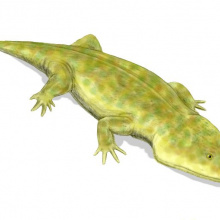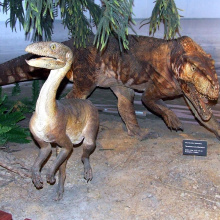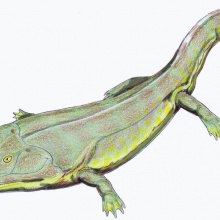A skeleton of a sileasaurus. Source: Wikipedia
The skeletons of a metoposaurus and a sileasaurus, casts of the skulls of a metaposaurus, a cyclotosaurus and a stagonolepis, as well as ammonites, will go to the Faculty of Biology of the University of Gdańsk, where an exhibition of ancient organisms will be organised. The animals come from the Triassic and Cretaceous periods, i.e. ca. 250-200 and 145-66 million years ago respectively.
The exhibits that the Faculty of Biology plans to borrow come from excavations conducted in the Opole region. Currently, they are in the collections of the University of Opole and Jura Park in Krasiejów. They will come to Gdańsk thanks to the kind commitment of the custodian of these collections, prof. Elena Yazykowa from the University of Opole.
Although these are not dinosaurs associated with giants like Tyrannosaurus or Diplodocus - they will be much smaller, as their body length does not exceed 3 m and their weight 200 kg - their age is impressive - the animals come from the Mesozoic era, more precisely from the Triassic and the Cretaceous, that is from ca. 250-200 and 145-66 million years ago respectively.
- 'I have been thinking about organising an exhibition of ancient organisms at the Faculty of Biology for a long time. I think that it is worth bringing closer the stories of creatures that existed on Earth before the appearance of men, which were very different from those living today,' says prof. dr hab. Dariusz Szlachetko, dean of the Faculty of Biology UG, the originator of the exhibition of ancient organisms. - 'The exhibition will be accompanied by educational materials in the form of charts with descriptions of the exhibits themselves, their living conditions, geological history of the Earth, changes in tectonic plates and climate, etc. Our building seems to be very well suited for this purpose. We already exhibit the skeletons of several large modern mammals (including the complete skeleton of a grey whale, the largest in Poland). This is a kind of memento, which should also make us realise how easy it is to lose biodiversity. I hope that in the future we will be able to enrich our exhibitions with larger specimens.'
The Department of Biology of the University of Gdańsk will receive:
- casts of skulls - Metaposaurus and Cyclotosaurus (large amphibians with a body length of about 2 m and a huge head occupying about a third of the body), Staganolepis (reptile - the largest in this group of organisms, weighing about 200 kg);
- Ammonites - animals related to modern octopuses, with shells about 80 cm in diameter;
- models of Metaposaurus and Silesaurus. The latter is particularly interesting, as it was described by Polish researchers based on findings from Krasiejów (hence the name - in free translation "lizard from Silesia").
The scheduled arrival date of the exhibits to Gdańsk is July 2021.
See the film (prepared by Trojmiasto.pl) about the already existing exhibition of mammal skeletons at the Faculty of Biology of the University of Gdańsk. Prof. UG, dr hab. Piotr Rutkowski from the Department of Taxonomy of Plants and Nature Conservation and dr Michal Goc from the Department of Ecology and Vertebrate Zoology of the Faculty of Biology of UG talk about the collected exhibits.
| Attachment | Size |
|---|---|
| Ekspozycja szkieletów ssaków na Wydziale Biologii UG - opis | 79.54 KB |



